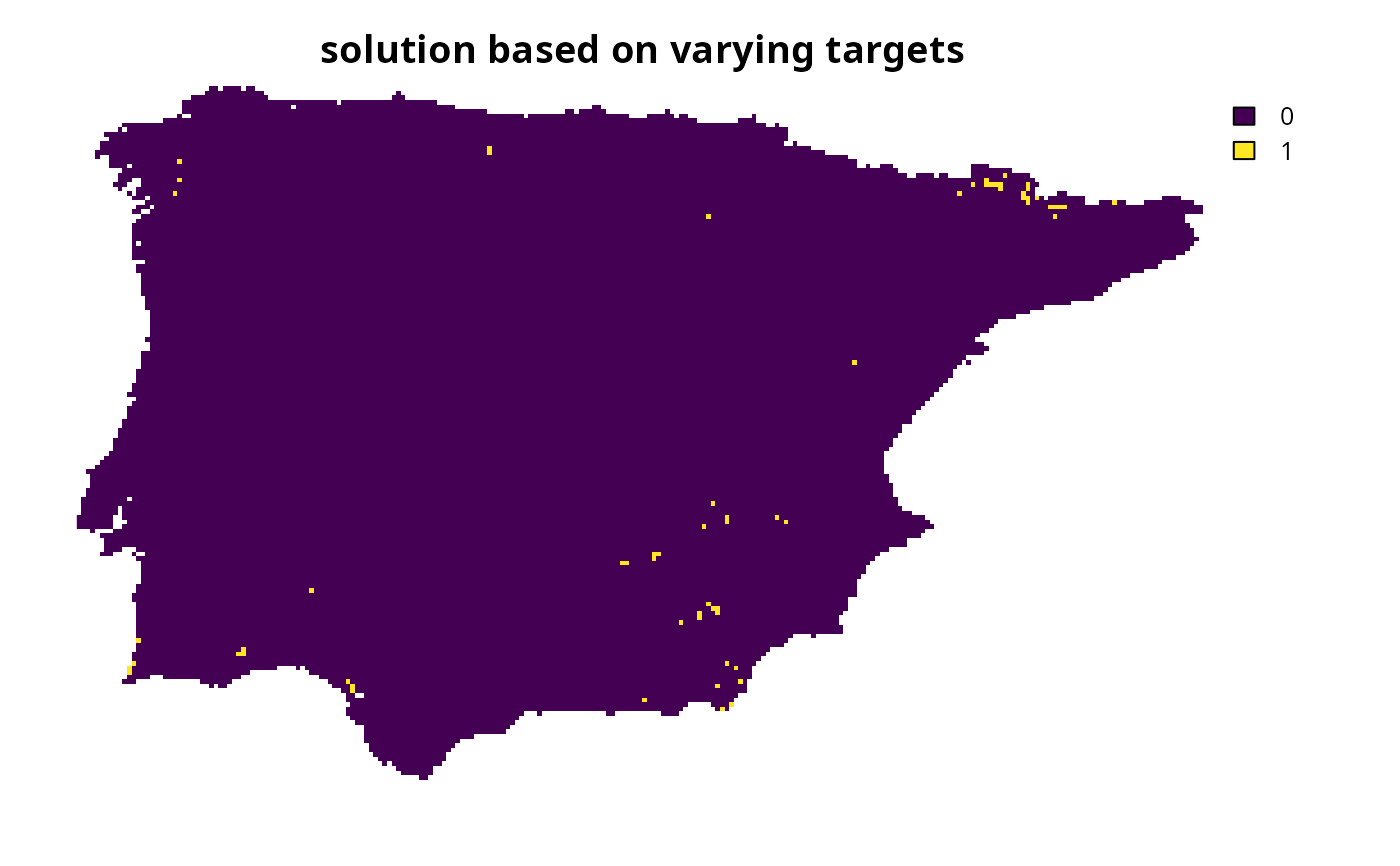Specify targets expressed as area-based units. For example, this function can be used to express targets as hectares, acres, or km2. To ensure feasibility, area-based targets are clamped based on the total abundance of features.
Arguments
- targets
numericvector denoting the area-based targets for the features. These values must be expressed in the same units asarea_units. If a singlenumericvalue is specified, then all features are assigned targets based on the area-based target.- area_units
charactervector denoting the unit of measurement for eachtargetsvalue (e.g.,"km^2","ha", and"acres"). If a singlecharactervalue is specified, then all features are assigned targets assuming thattargetsare in the same units.
Value
An object (TargetMethod) for specifying targets that
can be used with add_auto_targets() and add_group_targets()
to add targets to a problem().
Mathematical formulation
This method provides an approach for setting target thresholds based
on an area-based threshold.
To express this mathematically, we will define the following terminology.
Let \(f\) denote the total spatial extent of a feature (e.g., geographic
range size expressed as km2), and
\(a\) the specified area-based target
(expressed as km2,
per targets and area_units).
Given this terminology, the target threshold (\(t\)) for the feature
is calculated as follows.
$$
t = min(f, a)
$$
Data calculations
This function involves calculating targets based on the spatial extent
of the features in x.
Although it can be readily applied to problem() objects that
have the feature data provided as a terra::rast() object,
you will need to specify the spatial units for the features
when initializing the problem() objects if the feature data
are provided in a different format. In particular, if the feature
data are provided as a data.frame or character vector,
then you will need to specify an argument to feature_units when
using the problem() function.
See the Examples section of the documentation for add_auto_targets()
for a demonstration of specifying the spatial units for features.
See also
Other target setting methods:
spec_absolute_targets(),
spec_duran_targets(),
spec_interp_absolute_targets(),
spec_interp_area_targets(),
spec_jung_targets(),
spec_max_targets(),
spec_min_targets(),
spec_polak_targets(),
spec_pop_size_targets(),
spec_relative_targets(),
spec_rl_ecosystem_targets(),
spec_rl_species_targets(),
spec_rodrigues_targets(),
spec_rule_targets(),
spec_ward_targets(),
spec_watson_targets(),
spec_wilson_targets()
Examples
# \dontrun{
# set seed for reproducibility
set.seed(500)
# load data
sim_complex_pu_raster <- get_sim_complex_pu_raster()
sim_complex_features <- get_sim_complex_features()
# create base problem
p0 <-
problem(sim_complex_pu_raster, sim_complex_features) %>%
add_min_set_objective() %>%
add_binary_decisions() %>%
add_default_solver(verbose = FALSE)
# create problem with targets of 50 km^2 for each feature
p1 <-
p0 %>%
add_auto_targets(
method = spec_area_targets(targets = 50, area_units = "km^2")
)
# solve problem
s1 <- solve(p1)
# plot solution
plot(s1, main = "solution based on constant targets", axes = FALSE)
 # targets can also be specified for each feature separately.
# to demonstrate this, we will set a target value for each
# feature based on a random number between 5000 and 30000 hectares
target_values <- runif(terra::nlyr(sim_complex_features), 5000, 30000)
# create problem with targets defined separately for each feature
p2 <-
p0 %>%
add_auto_targets(
method = spec_area_targets(targets = target_values, area_units = "ha")
)
# solve problem
s2 <- solve(p2)
# plot solution
plot(s2, main = "solution based on varying targets", axes = FALSE)
# targets can also be specified for each feature separately.
# to demonstrate this, we will set a target value for each
# feature based on a random number between 5000 and 30000 hectares
target_values <- runif(terra::nlyr(sim_complex_features), 5000, 30000)
# create problem with targets defined separately for each feature
p2 <-
p0 %>%
add_auto_targets(
method = spec_area_targets(targets = target_values, area_units = "ha")
)
# solve problem
s2 <- solve(p2)
# plot solution
plot(s2, main = "solution based on varying targets", axes = FALSE)
 # }
# }
